| |
|
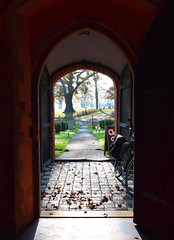 |
|
It was a crisp,
bright morning towards the end of
November 2016, a perfect day for a bike
ride. I'd had my eye on the weather
forecast all week, and first fog and then
cloud had been predicted, but Saturday
dawned to a crystal clear blue sky. I
headed out of town onto the Shotley
Peninsula, the first stretch of my
journey necessarily along the horrid main
road which runs along the south bank of
the Orwell. I soon came to Woolverstone,
which you can see at once was rebuilt as
a late 19th Century estate village. A
narrow lane runs between fields and
copses northwards to the church of St
Michael sitting on its mound above the
river.
The setting is idyllic. The great pile of
Woolverstone Hall, today home to Ipswich
Girls High School, stands beside it, and
above me the jackdaws chattered in the
skeletal trees, the fields were full of
sheep, the damp woods full of the cries
of pheasants. Woolverstone Hall was built
in the 1770s by John Johnson for William
Berners. Johnson had been the main
architect of the Berners Estate, an area
of London known more commonly today as
Fitzrovia, and the fabulously wealthy
Berners family took up residence in this
remote Suffolk spot above the Orwell.
They paid for George Gilbert Scott's
restoration of the 1860s, which is pretty
much all that can be seen of the church
from the south apart from the tower, but
in the 1880s they did rather more. |
James Piers St Aubyn, one
of the most famous architects of the day, was
brought in to expand the church massively towards
the north, and when you enter you see that the
effect is really that of two churches side by
side, separated by a fairly low and rounded
arcade. The new part was designed to be used for
shadowy, incense-led worship, and although that
tradition has long gone it is still the main part
of the church today.
The wealth of the Berners family means that the
restoration was overwhelming, but the quality of
it is high. And in any case, there are few
medieval survivals anywhere on the Shotley
Peninsula. The only old object here is the font,
and it is a curiosity. On the face of it, the
style is that of a typical East Anglian font
bowl, lions alternating with angels, but the
carving is quite unlike anything I've seen
elsewhere, the crouching lions shown in profile.
Pevsner calls the carving 'crude', which is not
untrue. Was it done by a local hand, perhaps? It
has been reset on a modern stem with upright,
alert little lions, 19th Century but much more in
the East Anglian medieval style.
The glass is also generally of high quality, or
at least expensive, and to various members of the
Berners family. Heaton Butler & Bayne's
rather alarmingly yellow Saints Martin, Agnes,
Margaret and Augustine, installed as a memorial
to Archdeacon Henry Berners and his wife, stand
proudly in an overwhelmingly wide south nave
window which works externally as a kind of
optical illusion, making Scott's nave appear
wider than his chancel, which it isn't.
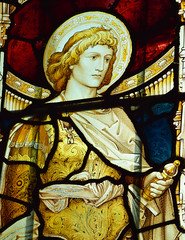 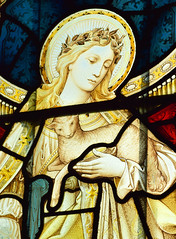  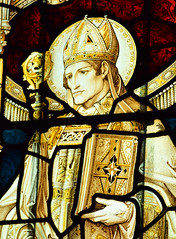
The same firm
provided the east window in St Aubyn's north
aisle to John and Henrietta Berners, which
depicts the crucifixion flanked by Joseph of
Arimathea, the Blessed Virgin, St John and St
Mary Magdalene. It is interesting to note, given
the not uncommon conflation of their imagery in
medieval times, the similarity between the
figures of St John and St Mary Magdalene. The
studio might almost have been working from the
same cartoon. Both the windows were installed in
the 1880s under St Aubyn's direction.
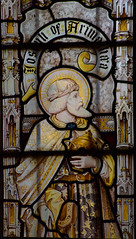 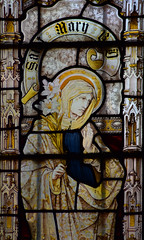 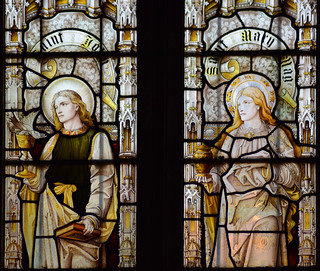
There was once
an earler 19th Century window at Gilbert Scott's
east end, of which the upper tracery survives,
but the main lights were destroyed by blast
damage during the Second World War, a not
uncommon fate for church windows on the Shotley
Peninsula - indeed, the church in the
neighbouring village, Chelmondiston, was
completely ruined. The 1947 replacement, by AL
Wilkinson, depicts Christ the Saviour of the
World flanked by St Michael and St Gabriel.
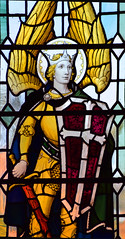 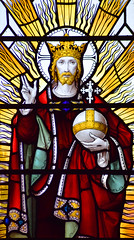 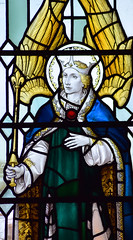
The High Church, even
Anglo-catholic, enthusiasms of the Berners family
may be judged by Woolverstone House back in the
village, which was built for a community of
Anglican nuns based at St Peter, Kilburn. It was
intended as their retreat house and school, and
the architect was Edwin Lutyens. Today it is a
private house, but the church is now open every
day. When I'd first visited every Suffolk church
in the late 1990s I had found it locked. Coming
back in 2006, the interior was full of
scaffolding, and I couldn't go in. Curiously, the
avenue of yew trees which lined the path up to
the south porch at that time have now been
reduced to stumps. Despite St Michael being
barely five miles from my house, it had taken
until this idyllic crisp, sunny day in late
November 2016 for me to get back there, discover
this, and explore the inside for the first time.
It was time to head on to Harkstead. The view
from the south porch back up the hilly lane was
breathtaking in the low winter sunshine. I
stepped out, wandering down to the east to look
across to the Hall.
| The Berners family
sold it as part of the Estate in 1937,
assuming that it would be demolished for
farming land, but after a period of
requisition by the army during the War
the Hall was bought by the London County
Council for use as a boarding school. It
was intended both for children taken into
care and also for those whose parents
were working overseas, an odd
combination, but people seem to have
happy memories of it. The writer Ian
McEwan is a famous ex-pupil. The school
closed in the 1980s; its massive library
was broken up, and you still regularly
come across items from it in Suffolk's
second-hand bookshops. In a grand sale in
the Ipswich Corn Exchange shortly after
the closure, I bought the school's copies
of McEwan's books for 50p each. The Hall
lay empty for several years, until the
Girls High School moved out here from
central Ipswich, and restored it to
something like its former glory. The
jackdaws which inhabit the great 19th
Century water tower, which stands beside
it, wheeled above my head as I cycled
back to the Shotley road. |
|
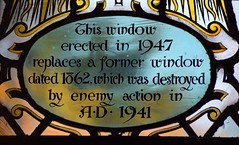 |
|
|
|

